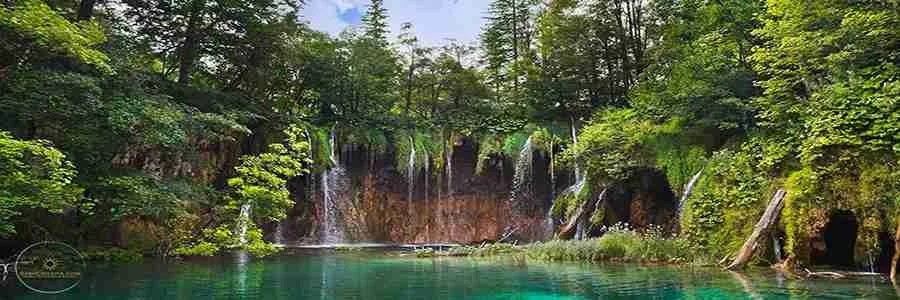Explore the Beauty of Croatia’s Coastal Region – Dalmatia
Discover the hidden gems of Dalmatia! Explore breathtaking beaches, rich history & delicious cuisine. Don’t miss this once-in-a-lifetime adventure! Dalmatia is a coastal region of Croatia situated along the Adriatic Sea, encompassing a central strip and several islands. Its width at its widest point on the mainland is about 28 miles. And it spans a total distance of 233 miles from the Kvarner Gulf to the Kotor Narrows. The major islands in Dalmatia, from north to south include Krk, Cres, Rab, Pag, Dugi Otok, Brač, Hvar, Vis, Korčula, Mljet, and Lastovo. The region is divided from the interior by the Dinaric Alps. A rugged mountain range with peaks ranging from 1,500 to over 6,200 feet. The coastline boasts many bays and harbors, and the mild climate with dry summers, abundant rain in the autumn and winter, and low snowfall contributes to its scenic beauty.

Dalmatia History
The first recorded inhabitants of Dalmatia were the Illyrians, and the name is thought to derive from the name of one of their tribes, the Delmata. Greeks began to settle in the region in the 4th century, founding colonies on the islands. Such as Issa, Pharos, and Corcyra Melaina, and a few towns on the mainland, including Salona. The Illyrians and Greeks were at odds, leading the Greeks to appeal to the Romans for help. Resulting in a long series of Roman-Illyrian wars.

Over the centuries, Dalmatia changed hands many times. With conquerors including Byzantines, Greeks, Magyars, Tatars, Croatian and Serbian princes, Venetians, Sicilians, and Normans. Venetian rule, established in 1420 and ending in 1797, had the greatest impact on the region’s character and consciousness. During WWI, the Allies promised northern Dalmatia to the Italians, which resulted in its transfer to Yugoslavia after the Treaty of Rapallo in 1920. Except for the mainland Zadar enclave and the coastal islands of Cres, Lošinj, and Lastovo. During WWII, Dalmatia was annexed by Italy, but became part of Yugoslavia as part of the Croatian Republic in 1947. With Split serving as the provincial capital.

Discover Dalmatia Historic Cities
One of the most iconic cities in Dalmatia is Split. The second-largest city in Croatia and home to the famous Diocletian’s Palace. This ancient Roman palace, built in the 4th century, is a UNESCO World Heritage Site. And one of the best-preserved examples of Roman architecture in the world. Visitors can explore the labyrinth of streets and buildings that make up the palace, including a temple, a church, and several residential buildings.

Another historic city in Dalmatia is Zadar, located on the northern coast of the region. This city is famous for its rich history, dating back to the Roman era. And is home to several ancient ruins, including a Roman forum and an aqueduct. In addition to its historical attractions, Zadar is also famous for its unique sunsets, which can be viewed from the city’s famous Sea Organ.

Discover Dalmatia Cuisine
Dalmatia Region is also famous for its cuisine, which is heavily influenced by the region’s rich history and location on the Adriatic Sea. Seafood is a staple of the local diet, and visitors can enjoy dishes such as grilled sardines, octopus’ salad, and fish stew. In addition to seafood, the cuisine of Dalmatia also features local specialties such as olive oil, figs, and dried fig cakes.

Discover Dalmatia Beaches
One of the main draws of Dalmatia is its stunning beaches. Many of which are located on the numerous islands that make up the region. Some of the most popular beaches include Zlatni Rat on the island of Brač and Sakarun on the island of Dugi Otok. These sandy beaches are ideal for swimming, sunbathing, and other water activities.

Another beach worth visiting is the famous Blue Lagoon, located on the island of Biševo. This hidden gem is popular for its turquoise waters and is a popular destination for snorkeling and diving.

Discover Dalmatia: Getting to Dalmatia
Dalmatia is easily accessible by several modes of transportation:

- By ferry: Direct ferries from Italy, such as from Ancona, Bari, and Pescara. As well as Jadrolinija ferries that sail along the Dalmatian Coast from Rijeka in the North Adriatic, provide convenient access to the region. Additionally, local ferry lines connect the mainland of Dalmatia to its islands.
- By plane: Airports in Zadar, Split, Dubrovnik, and Brac island, served by various airlines.
- By bus: Frequent bus services run from Zagreb Bus Station to Dalmatian cities and towns, as well as the coast. A frequent bus service along the Dalmatian coast connects Dubrovnik, Split, Zadar, Rijeka, and other places along the route.


